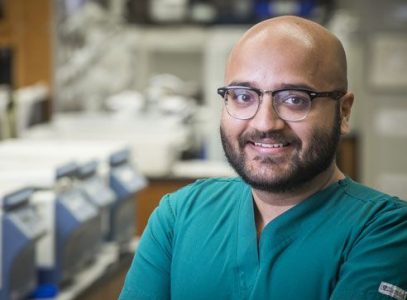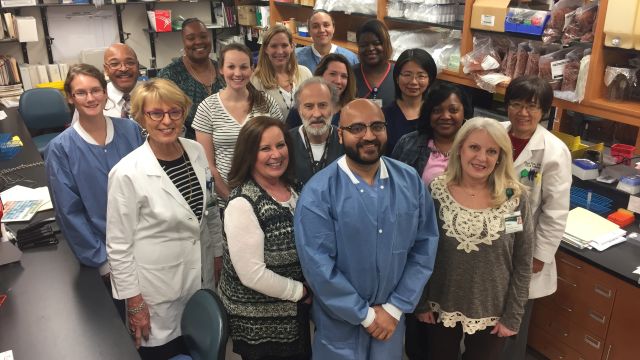
By Tyler Greer
UAB News

The folders lining the shelves of the University of Alabama at Birmingham’s Histocompatibility Lab represent people. Husbands and wives. Children and veterans. Mothers and fathers. Friends and strangers.
There are no faces attached to the folders, but there are names. There are ages. And, there are stories. Stories of need, and stories of hope. The folders represent more than 3,500 Alabamians and others from the Deep South waiting for a transplant that will – at the least – improve their lives, and – at the most – save them.
For Divyank Saini, a UAB lab technologist and one of 17 employees who work behind the scenes at UAB Hospital to bring hope to those waiting on heart, lung, kidney, liver and other transplants, interpreting lab samples to see which folder would match which just was not quite enough. Last year, Saini – known as Div by his colleagues – decided to donate a kidney to someone in need as part of the UAB Kidney Chain. The chain, which celebrated its three-year anniversary in December, has seen 67 patients receive a transplant since it began at UAB Hospital in 2013. At three years old, UAB has the world’s longest ongoing kidney chain.
The 30-year-old Saini became donor No. 57 in March when he donated to 73-year-old Birmingham native Earnestine Johnson, who was recipient No. 57.
“It’s been inspiring to me to see the chain of events working on it from behind the scenes,” Saini said. “To work in this lab and have the opportunity to donate myself, I had to take it. I had to help at least one person out, and this was my chance to do it.”
But by entering the chain, Saini kept it going beyond Johnson’s transplant, ensuring 10 more people after him would receive a new kidney. More transplants as part of the chain are expected in 2017.
“During dialysis, sometimes I felt like they were drawing too much blood, and I looked like a raisin,” Johnson said. “After the surgery, I noticed I could get around better. I don’t get out of breath as quick, and I can walk farther. I’m 73 years old, but I don’t look it. My doctors want me to go back to the dialysis place to show the other patients how good I’m doing. I’m so happy to be a part of this chain.”
Saini had an emotional meeting with Johnson and her family after the transplant, and the two have met a few times since then – most recently in December in Tennessee, where Johnson is staying with her daughter.
“Earnestine was great, so happy and full of life,” Saini said. “She seems revived and rejuvenated, and she’s doing things she couldn’t have done before. It makes it worth it. I’m glad my kidney has a good home, and I’m glad it went to her.”
Lab is key link in chain
UAB’s Histocompatibility Lab is one of about 200 such laboratories in the United States, and the only one in Alabama. The lab tests and monitors every solid organ, bone marrow and stem cell transplant patient from Children’s of Alabama, the Birmingham VA Medical Center and UAB. The lab performs testing on every recipient after transplant to monitor for rejection. Before transplant, the technologists in the lab run pre-transplant risk assessment for patients and donors to test for compatibility and make sure there are no problems with early rejection.
Vicki Cline, histocompatibility coordinator in the Histocompatibility Lab, is the only person in the lab who has contact with patients. She handles the logistics and sends kits to donors and recipients so they can get their lab work completed and tested on schedule. The technologists have to detect the donor’s and patient’s histocompatibility antigens – or HLAs – and check predetermined anti-HLA antibodies. That is what determines whom the donors will reject.
There is always some rejection going on in the transplanted patient’s body, said Vera Hauptfeld, Ph.D., director of the transplant laboratory.
“What we have to determine after testing is whether there is a high risk or low risk for rejection,” Hauptfeld said. “If there are no anti-HLA antibodies, those are the ones who are the best patient and donor combination. That goes for everything – deceased donors or renal, heart and lung, and for living donors. We make lots of interpretations. The results we receive from our tests are not cut-and-dried.”
Almost half of patients are found to be incompatible with their potential living donors. Just based on blood group frequencies, about 35 percent of patients who come forward with living donors will be blood-group-incompatible with their potential living donor. Another 11 percent will have tissue incompatibility.
For heart, lung and deceased-donor transplants, lab technologists examine each individual pair to look for pre-formed antibodies to the donor and analyze the risk. Zhuo Tao, M.D., associate director of the lab, and Hauptfeld then make the final review.
In terms of the kidney chain, determining which patients match with each other begins with Katie Stegner, nursing director of kidney paired exchange.
Stegner receives all of the HLA typing for the patients and donors from the Histocompatibility Lab. Stegner uses a database of kidney patients and their potential living donors to look for paired exchange possibilities. She sends all of the possible pairs she uncovers to Hauptfeld, who performs 95 percent of the virtual cross-match analysis and analyzes the risk.
Once the best pairs are determined, blood samples are taken the week before transplant for final cross-match analysis to make sure no changes in immunology have occurred.
“Once we know the patient receiving the kidney isn’t sensitized, then we give the final cross-match and go-ahead for transplant,” Hauptfeld said.
Even though lab technologists work with folders and do not interact with patients, Hauptfeld said the people behind the names are constantly in the forefront of their thoughts.
“We are all very aware that they are people, and not just folders or tubes,” Hauptfeld said. “Every folder and number has a name. We know how old they are. We know if they are young or if they are old. We can picture how they are. I think that impacted Div. When you think about what Div did, he is very much aware that there are a lot of people dying while waiting on a transplant. I think that motivated him.”

Modest man, reliable worker
Rebecca Burke met Saini a little more than six years ago after he graduated from the Medical Technology Program in UAB’s School of Health Professions and interviewed for a position as an entry-level bench technologist.
Lab employees work behind the scenes at UAB Hospital to bring hope to those waiting on heart, lung, kidney, liver and other transplants.
“The Histocompatibility Lab is probably the most vital piece to kidney transplant and certainly our program,” said Dr. Jayme Locke, surgical director of the Incompatible Kidney Transplant Program at UAB Hospital and coordinator of the UAB Kidney Chain. “They work tirelessly for our patients.”
Burke, now the administrative manager of the lab, said Saini immediately showed a passion for his work after he was hired. He passed his American Society for Clinical Pathology certification – credentials that demonstrate his competence to carry out the responsibilities of a clinical laboratory scientist – soon after he came on board.
Saini approached Burke in 2015 to ask if she would write a letter of recommendation on his behalf so he could pursue a master’s degree in Management Information Systems in UAB’s Graduate School, a pursuit in which he is now engaged.
He also has been a key contributor in implementing a critical new data system for the lab, a project that was almost two years from design to operation.
“Div has been amazing,” Burke said. “He’s really dependable, and his peers really recognize him as someone they can go to for help with questions, problems or issues. He really can crank out some work in the lab. He puts his head down, gets it done and makes it happen.”
Saini initially approached Burke a couple of years ago to inquire about what someone had to do if they wanted to donate a kidney. At the time, she thought he was questioning for a family member or friend.
“But he came forward later and said, ‘I want you to know, I’m really thinking about donating my kidney,’” Burke said. “I was like, ‘Wow. That’s pretty cool.’”
His co-workers learned he was going through the donation process when they received a vial of his blood for testing after he filled out the Living Kidney Donor Screening Form to see whether he would be a good donor candidate.
“His name was on the tube of blood we received, and it said he was an altruistic donor,” Hauptfeld said. “I went to him and said, ‘So you’re an altruistic donor?’ And he was very modest about it. He said, ‘Yes, I decided that I would do it.’ It was absolutely fantastic.”
“All of a sudden, he had a folder, and we were doing work-ups for him,” Burke said. “It really made each of us just in awe of that gift, that he would give of himself to help another person. We live that every day in the lab because we know the countless donors who come forward.”
Each of the lab’s technologists get to watch a living donor transplant after they are hired, which Burke said also makes a real impact.
“It gives you a better appreciation for what you are doing on the bench here when you see what happens with a transplant in the operating room,” Burke said. “You get to see it right there in front of you, which is really neat. And I think it really hit home for Div.”
Like every member of the Histocompatibility Lab, Saini is proud of the work they do.
“The lab and people I work with are amazing,” Saini said. “Because we are behind the scenes, sometimes the work they do goes unnoticed. They are very dedicated to their jobs and helping others. And they supported me throughout the process, even coming to see me when I was recovering. I think they were excited to know someone so personally who went through it since we don’t interact with patients.”
While the Histocompatibility Lab workers do not have one-on-one contact with the patients they serve, the pressure they feel to help someone battling kidney, heart, lung or other life-shortening disease is real, Saini said. The reward in helping someone realize a transplant is their payoff.
While the impact of his work in the lab did play a role in his decision to donate, perhaps more than that, Saini said the other donors in the chain motivated him to do more.
“It’s amazing to know that we had so many people willing to donate a part of themselves to a stranger,” Saini said. “It says a lot about Birmingham. It says a lot about humanity. We’re all ultimately altruistic people.”
Of the 67 donors in UAB’s record kidney transplant chain, many gave on behalf of a family member or friend so someone they knew could receive a kidney. Including Saini, 13 gave completely altruistically to a stranger.
If you are interested in exploring the opportunity to become a living organ donor, visit UAB Medicine today and fill out the Living Kidney Donor Screening Form. You can also see first-person and video stories from the UAB Kidney Chain at www.uab.edu/kidneychain, or follow along on Facebook and Twitter at #UABKidneyChain for more.



